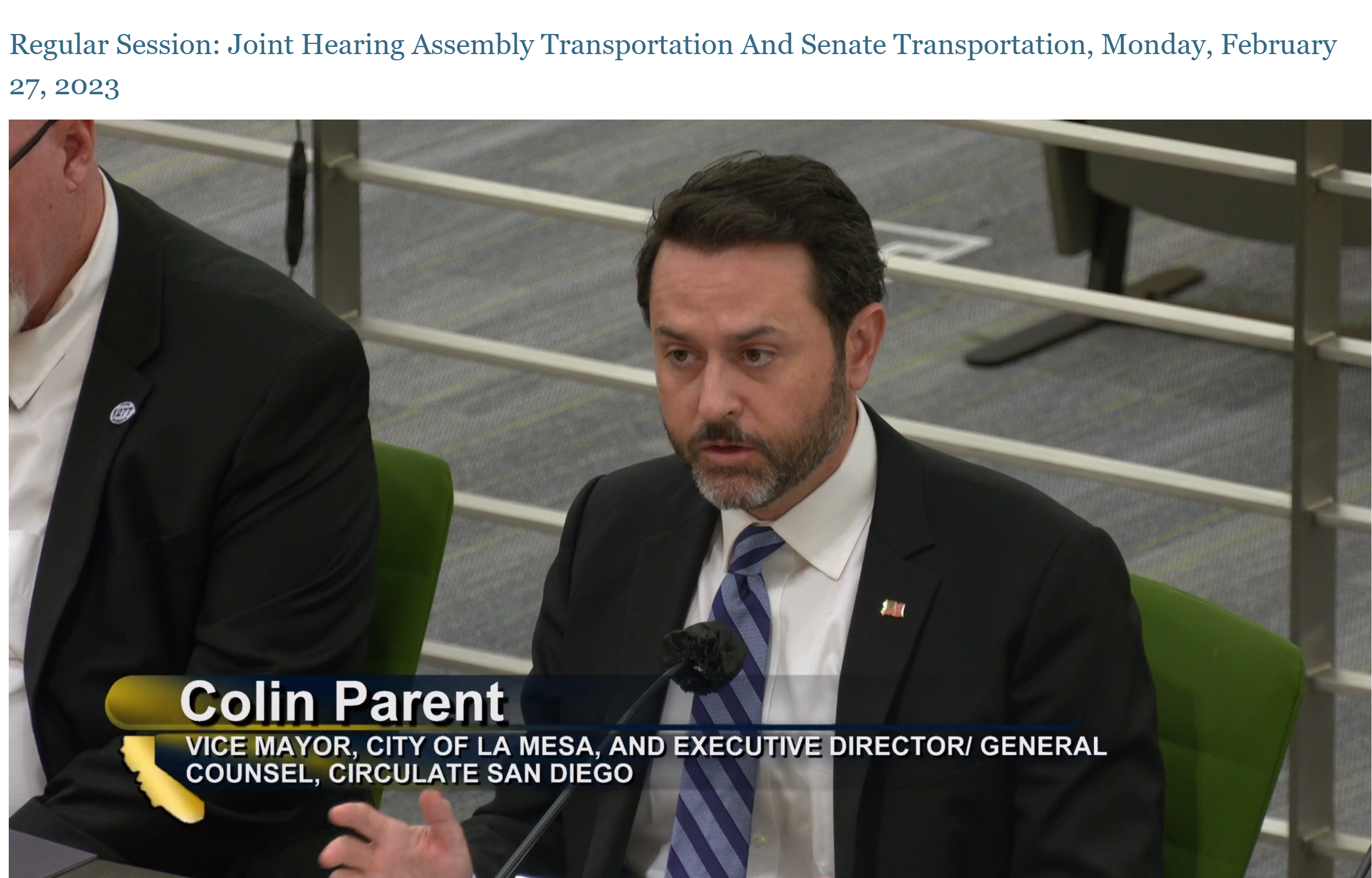Press Release - February 28, 2023
Contact: Colin Parent
[email protected] | (619) 567-6856
CIRCULATE SAN DIEGO EXECUTIVE DIRECTOR COLIN PARENT TESTIFIES IN CALIFORNIA LEGISLATURE ON THE FUTURE OF TRANSIT FUNDING
Yesterday Circulate San Diego Executive Director Colin Parent testified to a joint hearing of the Assembly Transportation and Senate Transportation Committees in the California State Legislature.
Parent was invited to speak on a panel of transit stakeholders, to discuss the funding
issues facing transit agencies throughout California. After the COVID-19 pandemic,
transit ridership has declined, reducing fare revenues, and forcing transit agencies to
consider reducing bus and train schedules.
Archived video from the hearing will be posted online here:
https://www.assembly.ca.gov/media-archive.
Below is the testimony Parent provided to the California Legislature:
Good afternoon. My name is Colin Parent. I am the Vice Mayor of the City of La Mesa. I
am also the executive Director and General Counsel for the nonprofit think tank
Circulate San Diego.
Circulate San Diego is a leading voice in our region about transit, safe streets, and
sustainable growth.
We’ve published numerous research reports on public transit and mobility. And we’ve
waged and won numerous campaigns to improve service and access for transit riders
in San Diego.
Public transit in California serves a lot of functions. It’s a major component of the state
and local efforts to address climate change. Transit is a major employer, with lots of bus
drivers, mechanics, and more, with good union jobs.
But the most important thing that transit does, is to serve the interests of transit riders.
And if we are going to live up to our ideals as progressives and as advocates for transit
riders, we have an obligation to listen to those transit riders.
The national nonprofit TransitCenter conducts a periodic survey of current and potential transit riders. That data routinely shows that the top priority of transit riders nation-wide is the frequency of transit service, and the overall speed of transit trips.
In my back yard, the San Diego Metropolitan Transit System conducts a similar survey,
and it finds the same results.
Transit riders say they are concerned with quality service, above other considerations
like the availability of parking, or the overall cost of transit fares.
This makes perfect sense if you’re putting yourself in the shoes of a low-income transit
rider. Telling a worker who gets paid by the hour that you’re going to save them save them the cost of a $2.50 fare, is cold comfort, if that fare is for a bus ride that takes two hours. They would be able to earn more money if so much of their day wasn’t eaten up by a burdensome, long bus commute.
By almost any measure, driving is more expensive than taking transit. Yet many people
choose to drive, despite the higher costs.
So the way to attract new transit riders is not to lower fares, which are already
substantially lower than the cost of driving.
Instead, the way to attract more transit riders is to improve the quality of service, so that
it is more competitive with the car. That means running buses and trains more
frequently, and across more hours in the day. That also means funding bus-only lanes so that the bus is faster and more competitive with driving.
Circulate San Diego collected a number of these recommendations for how to improve
transit service in our recently-published report titled “Fast Bus!”
As California transit agencies are facing a looming fiscal cliff, the legislature should be
looking at ways to ensure that transit service is maintained, and improved.
Investing in service can bring back riders, and rebuild transit agencies’ financial
sustainability.
There are some important options for the legislature to consider for helping transit
agencies maintain and improve service.
First, the legislature provided billions in new capital dollars for transit in last year’s
budget. The legislature should amend that allocation and allow local agencies to use
that funding for operations and service. That is the priority for transit riders.
California has some innovating funding mechanisms for transit, including the Affordable Housing and Sustainable Communities program, or AHSC.
The AHSC program uses Cap-and-Trade revenue to fund affordable housing
developments, if they’re paired with improvements to transit. But the money currently
only can be used to fund new transit capital costs.
This can make transit agencies resist participating in AHCS applications. They don’t
want new transit lines built, if they don’t have any new monies to pay for ongoing
operations.
The legislature should amend the AHSC program to allow those funds to pay for transit
operations, not just capital. That will allow the program to fund the priorities of transit
riders. And it will transform transit agencies from reluctant participates, into enthusiastic ones.
In summation, I want to invite the legislators here today to prioritize the interests, and
preferences of transit riders.
Transit riders say that frequency and speed are their priority. Studies show that high
quality transit service attracts riders, and revenues.
Let’s help transit agencies succeed, by helping transit riders themselves.
###

